Is It Safe to Eat Shrimp With Freezer Burn
Eating shrimp with freezer burn is generally safe, but it may not be enjoyable. Freezer burn occurs when food is exposed to air in the freezer, causing moisture loss and dehydration. This results in white or grayish spots on the shrimp and can affect its texture and flavor. While it won't make you sick, freezer-burned shrimp might taste dry or have an off-flavor. You can still cook and eat it, but you may want to use it in dishes with strong flavors or sauces to mask any unpleasant taste. To prevent freezer burn, store shrimp in airtight containers or vacuum-sealed bags. If you're curious about improving the quality of your frozen seafood, there's more to explore.
This post may contain affiliate links. If you make a purchase through these links, I may earn a commission at no additional cost to you. Additionally, portions of this post may be generated using artificial intelligence (AI) technology. While we strive for accuracy, please be aware that AI-generated content may not always be perfect and should be fact-checked when necessary.
The Spatula Scoops
- Freezer burn does not make shrimp unsafe to eat, but it affects quality, flavor, and texture.
- Properly cooked freezer-burned shrimp is generally safe for consumption, though less appealing.
- Inspect shrimp for signs of spoilage or off-odors before cooking, discarding if excessively deteriorated.
- Cooking techniques like marinating or using flavorful sauces can mask off-flavors in freezer-burned shrimp.
- While safe to eat, freezer-burned shrimp may be best used in dishes like soups or stir-fries to minimize texture issues.
Understanding Freezer Burn on Shrimp
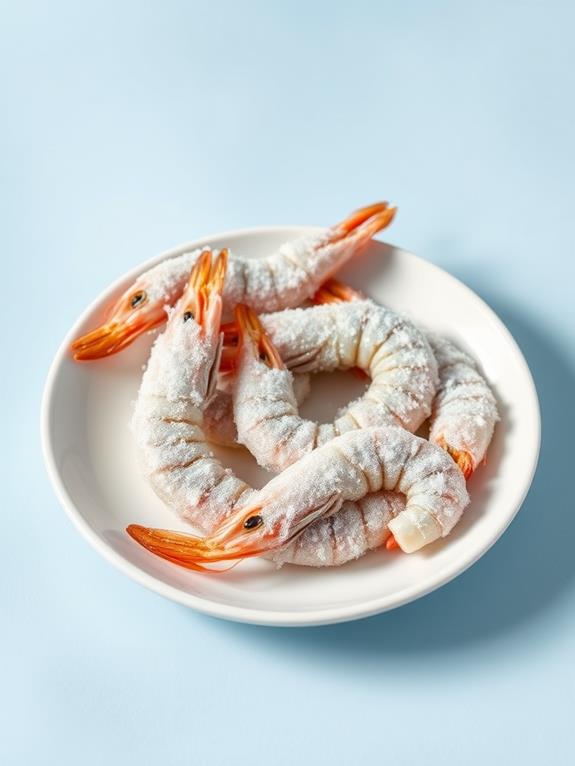
Freezer burn can be a shrimp lover's nightmare. When you're looking forward to a delicious seafood meal, discovering your frozen shrimp have developed those telltale white or grayish spots can be disappointing. To avoid this situation, consider using silicone freezer trays, which can help preserve the quality of your shrimp by minimizing air exposure during storage Souper Cubes Gift Set. But what exactly is freezer burn, and how does it affect your shrimp?
Freezer burn occurs when your frozen shrimp are exposed to air inside the freezer. This exposure leads to moisture loss and dehydration, resulting in those dry, discolored patches you might notice on your shrimp. While it may not look appetizing, it's important to understand that freezer burn doesn't necessarily make your shrimp unsafe to eat. However, it can greatly impact the quality, flavor, and texture of your seafood.
To prevent freezer burn on your frozen shrimp, you'll want to use airtight containers or vacuum-sealing methods for storage. These techniques help minimize air exposure and maintain the shrimp's quality. If you do end up with freezer-burned shrimp, don't despair. Proper cooking techniques can help make them more palatable, though they may not fully restore the original taste and texture.
Safety Considerations for Frozen Seafood

When it comes to frozen seafood's safety, proper handling and storage are paramount. The USDA confirms that frozen shrimp and other seafood are generally safe from bacterial growth, but you must be vigilant about how you handle and thaw these products to prevent contamination. Cooked seafood should never be left at room temperature for more than 2 hours, as this can lead to a risk of foodborne illness safety guidelines for cooked chicken.
While freezer burn doesn't make shrimp unsafe to eat, it can affect its quality. You'll want to inspect your frozen shrimp for signs of freezer burn, such as discoloration or dry patches. If you notice these signs, don't panic—it can help mitigate the effects. However, if the freezer burn is excessive or you detect off-odors, it's best to avoid consuming the shrimp altogether.
Identifying Quality in Frozen Shrimp
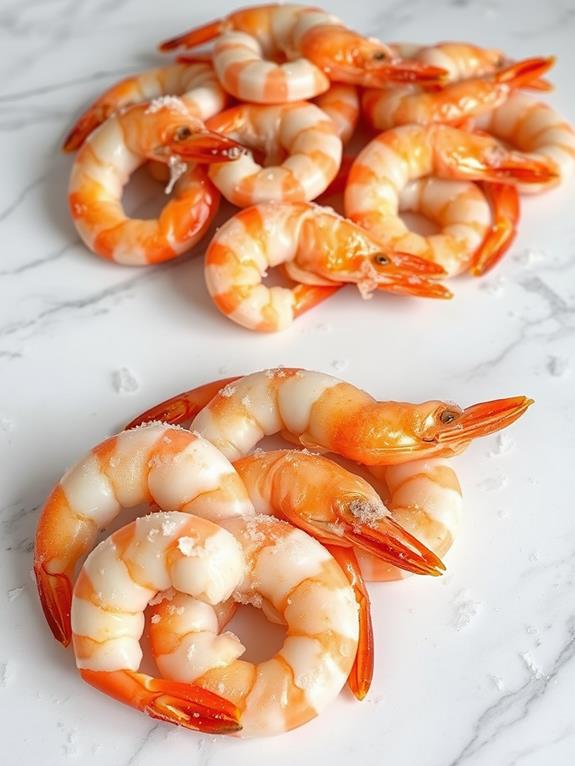
Knowing how to spot quality frozen shrimp is key to ensuring a satisfying meal. When you're inspecting your shrimp, look for a moist and shiny appearance. If you notice dry patches or discoloration, these are signs of freezer burn. You might also consider using containers that minimize freezer burn risk, such as Souper Cubes silicone molds for storing leftover shrimp dishes. You'll want to avoid freezer burned shrimp, as they can affect both taste and texture.
Check for ice crystals on the shrimp, as these indicate moisture loss and dehydration. Quality shrimp should feel firm to the touch, while freezer-burned shrimp might be mushy or tough. Use your nose, too. Fresh shrimp should have a mild, pleasant saltwater aroma. If you detect a strong, off, or unusual smell, it's best to discard the shrimp.
Visual cues are essential. Look out for grayish spots or an opaque white appearance, which can indicate quality issues. Remember, freezer burned shrimp may still be safe to eat, but the texture and flavor will likely be compromised. By paying attention to these details, you'll be able to select the best quality frozen shrimp for your dishes, ensuring a more enjoyable dining experience.
Cooking Freezer Burned Shrimp
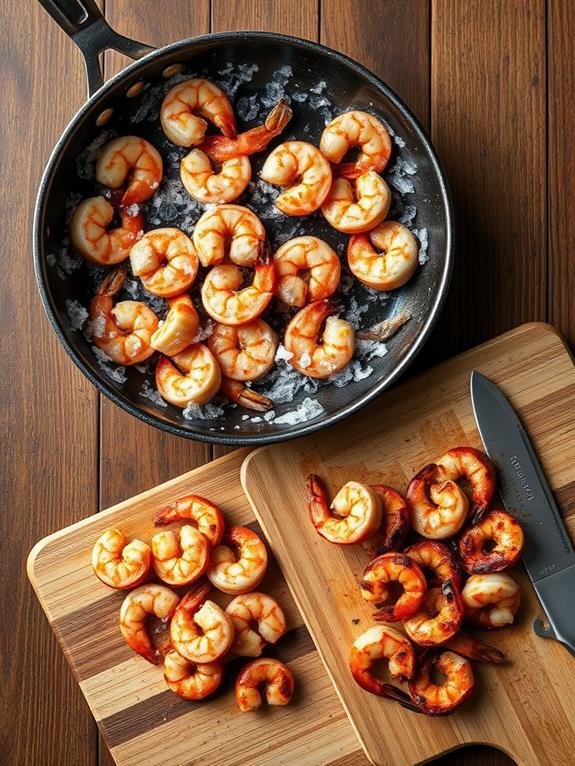
Cooking freezer burned shrimp doesn't have to be a culinary disaster. While the quality may have diminished, it's still OK to eat. Your main focus should be on enhancing flavor and improving texture. Consider marinating the shrimp or using flavorful sauces to mask any off-flavors. When it comes to cooking methods, you've got options:
| Method | Benefits | Tips |
|---|---|---|
| Boiling | Even cooking, versatile | Add herbs and spices to water |
| Sautéing | Quick, retains texture | Use high heat, don't overcrowd |
| Soups | Disguises texture issues | Incorporate strong flavors |
Preventing Freezer Burn
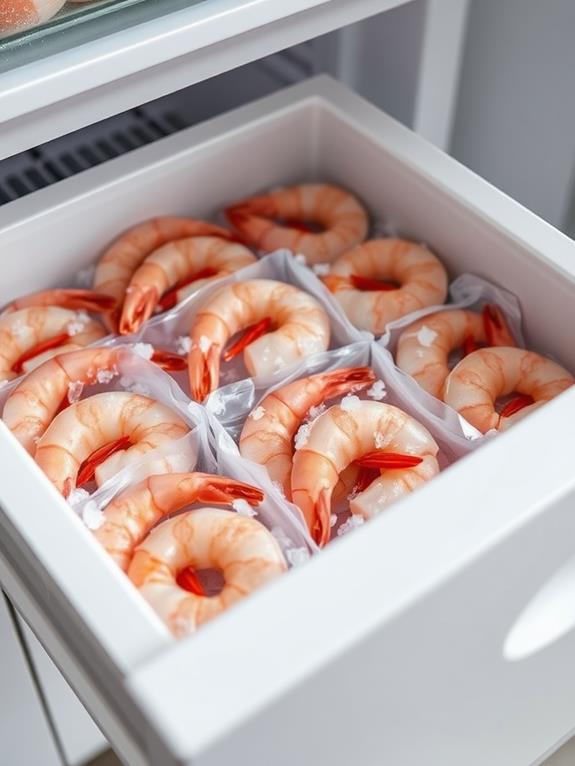
While cooking freezer burned shrimp can be manageable, it's best to prevent the issue altogether. To keep your shrimp ok and free from freezer burn, you'll need to focus on proper storage techniques. Start by using airtight containers or vacuum seal packaging to minimize air exposure, which is the primary culprit behind freezer burn. For example, using leak-proof containers can be an effective way to guarantee no air contacts your shrimp, maintaining their quality. Maintaining a consistent freezer temperature below 0°F (-18°C) is essential for preserving your shrimp's quality. Remember to freeze shrimp promptly after purchase to lock in freshness and reduce moisture loss. To stay organized and guarantee you're using your shrimp within a reasonable timeframe, always label packages with dates.
Here are three key steps to prevent freezer burn on your shrimp:
- Use airtight packaging to limit air exposure
- Keep your freezer temperature consistently below 0°F (-18°C)
- Avoid thawing and refreezing shrimp multiple times
Storage Tips for Frozen Shrimp

To maximize the shelf life of your frozen shrimp, you'll want to focus on three key areas: proper packaging, ideal freezer temperature, and smart rotation practices. Start by wrapping your shrimp tightly in moisture-proof, freezer-safe packaging to prevent air exposure and freezer burn. Utilizing tools like a KitchenAid Citrus Juice Press Squeezer can help you to prepare delicious marinades, enhancing the flavor of your shrimp before freezing. Keep your freezer at 0°F (-18°C) or below, and make sure to label your packages with the date of freezing, rotating older items to the front for timely use.
Proper Packaging Techniques
Proper packaging techniques are vital for maintaining the quality of frozen shrimp and preventing freezer burn. To keep your shrimp from developing those unappetizing opaque white patches, you'll want to minimize air exposure. Here's how you can do that:
- Use vacuum sealing methods to remove as much air as possible before freezing.
- If vacuum sealing isn't an option, opt for airtight containers or heavy-duty freezer bags.
- Squeeze out excess air from bags before sealing them tightly.
When using containers or bags, make sure they're designed for freezer use to provide adequate protection. Don't forget to label each package with the freezing date, as this helps you track storage time and maintain peak quality.
Maintaining a consistent freezer temperature below 0°F (-18°C) is essential. This prevents thawing and refreezing cycles that can lead to freezer burn. Be mindful not to overload your freezer, as this can impede proper air circulation and increase the risk of freezer burn on your stored shrimp.
Optimal Freezer Temperature
Maintaining the right freezer temperature is essential to preserving your shrimp's quality and preventing freezer burn. For ideal storage, keep your freezer below 0°F (-18°C). This temperature greatly reduces the risk of freezer burn and maintains the quality of your seafood. When you bring home a bag of frozen shrimp, make sure it goes straight into the freezer to maintain its temperature.
Consistency is vital when it comes to freezer temperatures. Fluctuations can lead to moisture loss and ice crystal formation, affecting your shrimp's texture and flavor. To preserve freshness for up to 6-12 months, keep your freezer at a steady temperature. Regular checks and maintenance of your freezer's temperature setting will help avoid quality degradation and preserve nutritional value.
Here's a quick reference guide for ideal shrimp storage:
| Temperature | Storage Method | Expected Quality |
|---|---|---|
| Below 0°F | Vacuum Sealed | Excellent |
| Below 0°F | Airtight Container | Very Good |
| 0°F to 10°F | Original Packaging | Good |
| 10°F to 32°F | Any Method | Poor |
| Above 32°F | Any Method | Unsafe |
Rotation and Labeling
Organization is key when it comes to storing frozen shrimp. To keep your seafood fresh and easily accessible, you'll want to implement a system of rotation and labeling. This practice guarantees you're using your shrimp within the ideal storage period of 6-12 months, maintaining quality and preventing waste.
Start by properly labeling each package of shrimp with the date of purchase or freezing. Then, follow these steps for effective rotation:
- Place newly acquired shrimp at the back of your freezer.
- Move older packages to the front for easy access.
- Keep an inventory list to track what you have and when it was frozen.
It's OK to use a dry-erase board or digital app to manage your frozen seafood inventory. This method simplifies meal planning and helps you avoid forgotten items that might develop freezer burn. By rotating your shrimp regularly, you're minimizing the risk of quality degradation and guaranteeing you're always using the oldest packages first. Remember, proper rotation practices are vital for maintaining the freshness and safety of your frozen shrimp, so make it a habit to check and update your inventory regularly.
Consumer Experiences and Recommendations
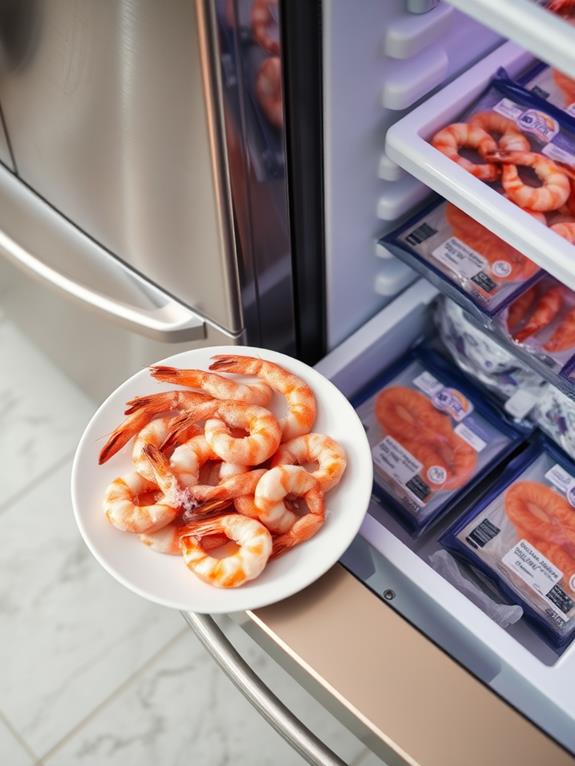
When it comes to freezer-burned shrimp, consumers' experiences and recommendations paint a reassuring picture. You'll find that many people report these shrimp are safe to eat, provided they've been properly cooked and handled. While the quality might not be excellent, you can still enjoy them in various dishes. It's also worth noting that, similar to expired tofu, inspecting for spoilage is essential; freezing at or below 0°F (-18°C) helps inhibit the growth of harmful bacteria, ensuring that the shrimp remains safe for consumption if stored properly inspect tofu for spoilage signs.
If you're wondering how to use freezer-burned shrimp, consider incorporating them into soups or stir-fries. These dishes are less dependent on perfect texture, making them ideal for slightly compromised shrimp. To enhance flavor, you might want to try seasoning or marinating the shrimp before cooking. This can help mask any off-tastes associated with freezer burn.
It's important to remember that appearance doesn't always indicate safety. Many consumers, including those on platforms like TikTok, emphasize that freezer-burned shrimp can be perfectly edible despite their looks. The key is thorough cooking. While freezer burn might affect quality, it doesn't necessarily make the shrimp unsafe. By following proper cooking methods, you can still enjoy your freezer-burned shrimp without worry.
Frequently Asked Questions
Can I Eat Freezer Burnt Shrimp?
Yes, you can eat freezer burnt shrimp, but it might not be as enjoyable as fresh shrimp. Freezer burn doesn't make shrimp unsafe, but it can affect the texture and flavor. You'll notice dry patches or discoloration, which are signs of moisture loss. To improve the taste, cook the shrimp thoroughly and consider using seasonings or sauces. Always check for other signs of spoilage, like off-odors or sliminess, before consuming. If you're unsure, it's best to err on the side of caution.
How to Tell if Shrimp Has Gone Bad in the Freezer?
Just as a wilted flower signals its decline, shrimp in your freezer can show signs of spoilage. You'll want to check for noticeable discoloration, dry patches, or a strong, off-putting odor. If the texture feels mushy or slimy instead of firm, that's a red flag. Look out for excessive ice crystals, which might indicate freezer burn. While freezer burn doesn't necessarily mean the shrimp is unsafe, it's best to inspect for any associated spoilage signs before cooking. Trust your senses and err on the side of caution.
Is It Safe to Eat Expired Frozen Shrimp?
It can be safe to eat expired frozen shrimp if they've been stored properly at consistent temperatures below 0°F. You'll want to check for signs of spoilage like ice crystals, discoloration, or strong odors. While they might not be harmful, the quality and taste may have degraded. To be extra cautious, cook the shrimp thoroughly. Remember, proper storage is key, and it's always best to follow expiration dates for peak quality and safety when dealing with frozen seafood.
Is Freezer Burn Safe to Eat?
Hey, don't flip your wig! Freezer burn is generally safe to eat. It's not a safety issue, but rather a quality concern. You'll notice dry patches, discoloration, and texture changes in freezer-burned food. While it's safe, the flavor and texture may be compromised. You can still use freezer-burned items in cooking, especially in dishes like soups or stews. However, if you notice strong off-odors or extreme discoloration, it's best to discard the item as it might indicate spoilage.





